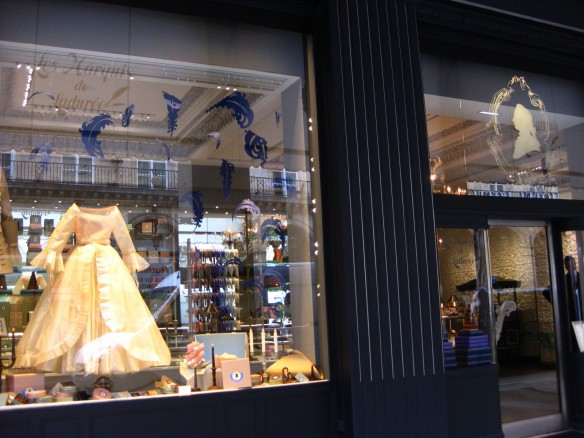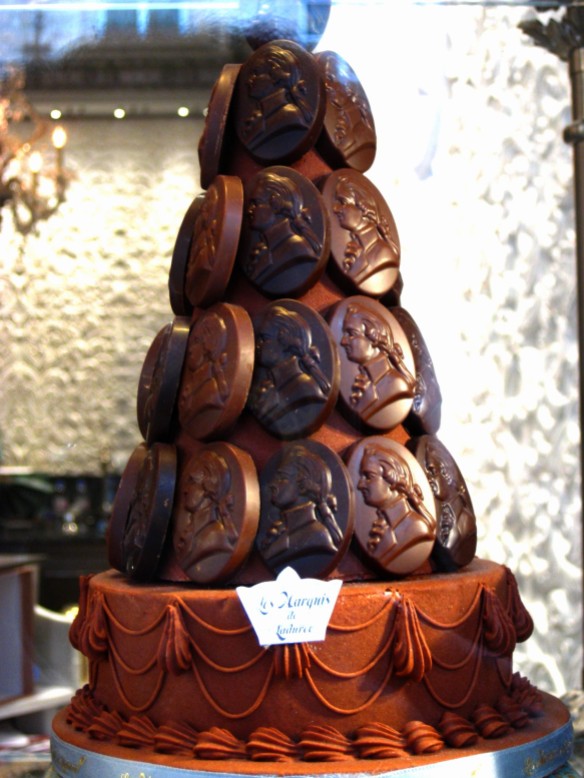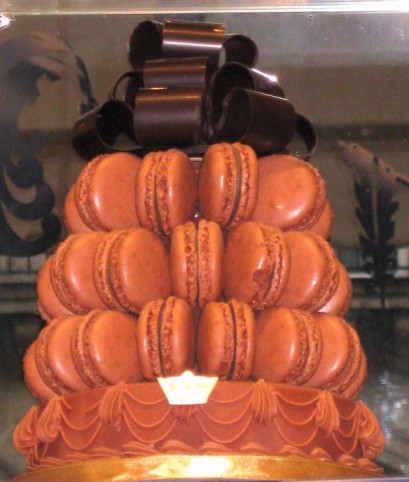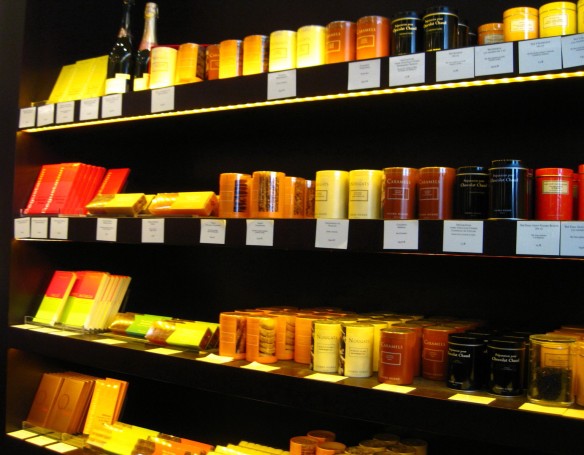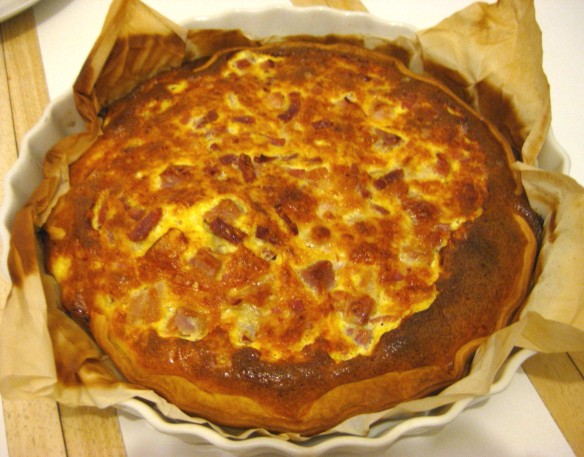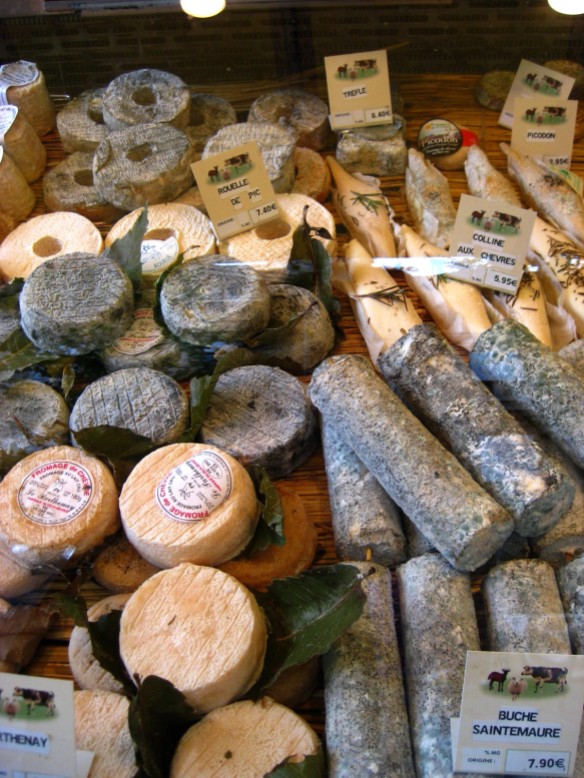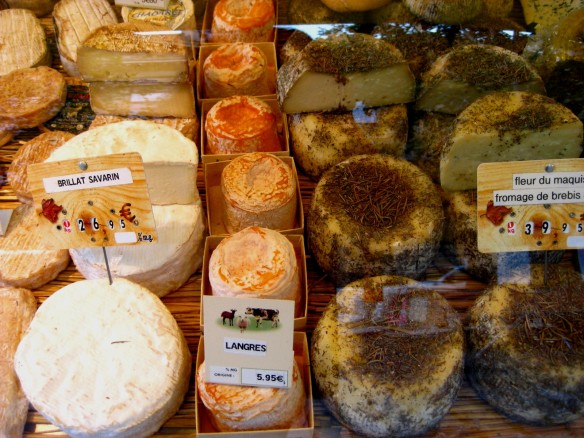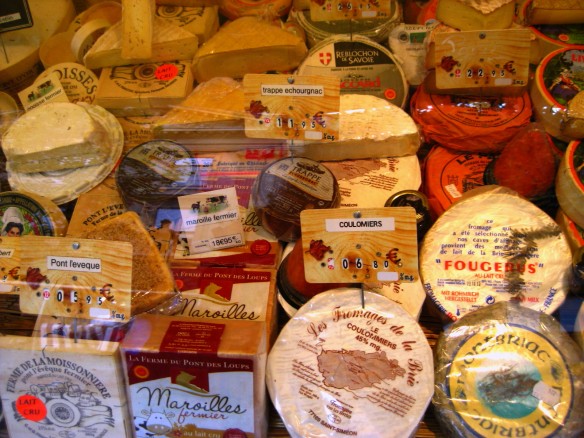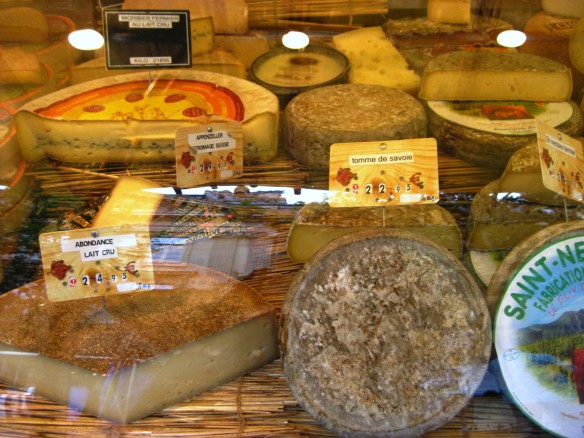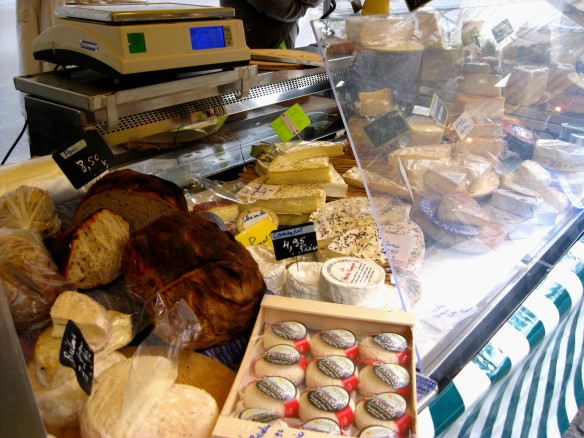For all that the French are respected for their perfumes, they are perhaps even more known for their food. It is something that is an inherent part of their way of life, beyond just the rarefied, perhaps more sophisticated confines of Paris. Food permeates every part of the French life and cultural psyche, be it a truck driver in Normandie or a wealthy housewife in Cannes. It’s no different in Paris, though the breadth, nature and diversity of the offerings may be slightly greater.
As someone whose primary passion in life is food and gastronomy instead of perfume, Paris was a visual bonanza, as much as any actual one. From the beauty of the windows at the competing, rival houses of Ladurée and Pierre Hermé, to the bounty of an extremely small, ordinary food market, to elaborate haute cuisine menus from the “Chef of the Century, Joel Robuchon, or simple oyster displays at a local restaurant, Paris is truly “a moveable feast” for the eyes.
Luckily, I got to actually eat a few things, too, particularly my beloved French cheese. As regular readers of the blog will know, I have an incredible passion — nay, an obsession, in fact — with that particular French speciality. And I was utterly spoiled in Paris — a situation which was sharply borne home to me upon my return to America. A recent attempt to get 10 favorite French cheeses at a very high-end store here resulted in my being told that 8 of them were illegal in this country, and could not be imported in due to FDA rules. (My feelings on that subject are as bitter as my feelings on IFRA/EU restrictions.)
You know that famous, old saying, “We’ll always have Paris”? Well, I’ll always have my photos. So, without further ado, let’s have some food porn. (For non-Americans, the term refers to a visual feast of photos highlighting deliciously tempting food.) First up, chocolates. As some of you know, the two big rival houses are the very old, established Ladurée which dates back to 1862, and the newer star of the macaron scene, Pierre Hermé. Macarons (which are not the same as macaroons) consist of a double-decker of two thin, pastry (or cookie) shells which are stuffed in-between with a creamy ganache filling. According to Wikipedia‘s entry for the company, Ladurée is the one who first invented this structure in the 1930s.
While some swear that Ladurée makes the best macarons (and chocolates) in the world, others vehemently insist that it is really Pierre Hermé, who Vogue once called “the Picasso of pastry.” Wikipedia explains his significance and background much more succinctly than I could manage:
Pierre Hermé macarons are airy cookies of egg-white and almond chair, sandwiching a cream filling. Perhaps his most famous is the Ispahan, made with rose, lychee, and raspberry; he likened it as their “Chanel suit” — the one they sell the most.[1] [¶] Hermé’s chocolates are also renowned. His chocolate cake made it on The Observer‘s “50 best things to eat in the world” list in 2009.[2]
His cooking philosophy: He prefers discreet pastry decors and “uses sugar like salt, in other words, as a seasoning to heighten other shades of flavor.”[3] He often makes daring use of savory ingredients in his desserts: traces of balsamic vinegar, Parmesan or olives in his cakes and layered dessert creams; he has even used grilled corn in a cake. […]
Pierre Hermé began his career at the age of 14 as an apprentice in Paris with the acclaimed pâtissier Gaston Lenôtre, who Hermé says is his greatest influence. At age 24, he became the pastry chef at the fine food merchant Fauchon, where he remained for 11 years. […] Pierre Hermé was the youngest person ever to be named France’s Pastry Chef of the Year, and is also the only pastry chef to have been decorated as a Chevalier of Arts and Letters.
I went to both Ladurée and Pierre Hermé, at various different locations, and my vote goes to the latter. Pierre Hermé’s macaron shells were truly like air, while Ladurée’s were thick, chewy, and incredibly dense. The ganache filling inside also was more intensely flavourful at Pierre Hermé, though only by a hair. However, Ladurée wins hands down for the chic-est shops, all across Paris, inside and out, and with the best displays. The Pierre Hermé location near the l’Opera was dark like a cave, and I didn’t think much of the latticed tea boxes in the window. It was better at the St. Gérmain location where the window had cocoa beans presented as lollipops, but it still couldn’t quite compare to the elegance of the Ladurée displays. Speaking of that cocoa bean display, I got to stare at it quite a bit, as I had to consistently stand in long queues streaming out the door and onto the sidewalk merely in order to get into the store which is tiny, narrow, and smaller than some walk-in closets. Still, it was worth it for the sheer delight of his macarons! A photo comparison of the two brands:
Ladurée:

Some of the Ladurée macarons, with the green ones being pistachio if I remember properly and the light ones to the left having a passion fruit center.
Now for Pierre Hermé:
While both stores feature plenty of “eye candy,” there were numerous shop windows or restaurant displays that also caught my eye. From street sweets on a cart near the Pompidou center, to a shop filled with things like violet candies, to the gorgeous sea food and the oyster menu of one restaurant which offered the high-end Gillardeau Especiales oysters that Neela Vermeire once mentioned in her interview as being her absolute favorite. My eye was also caught by the menu on the exterior wall of one bistro which featured quite a few of my favorite things, from rognons de veau (veal kidneys that are usually done in a red wine sauce) to tarte tatin (a thick, twice baked, hot, caramelized apple pie that is cooked upside down). Then, there was the adorable Jewish deli and bakery in Le Marais, the old Jewish quarter of Paris that is also home to a lot of Russians and Poles. Some of the photos in small thumbnails that you can click on to expand:
As some of you may remember from another holiday post, I spent most of my time in Paris staying with a friend from high school. She is one of my oldest friends, knows me and my tastes extremely well, and was an incredible host who practically greeted me with a large platter of cheese. It is hyperbole, but not all that far off the mark.
In addition to replenishing the cheese stock each and every day, she also made what was the single most delicious quiche I’ve ever had in my life. And that part is not hyperbole at all. As we stood talking in her kitchen, she casually whipped up — from scratch and with nary a look at a recipe — a cheese and ham quiche that was something so glistening, so huge, so bursting with flavour, and with such an enormously high, buttery, golden crust, that I’m actually swallowing my saliva as I write.
I have decided that her savory delight was so remarkable that I have officially christened it as Emmanuelle’s Quiche, or Emma’s Ultimate Quiche. The photos do its magnificence no justice at all. The airy, smooth, fluffiness of the creamy egg mixture was infused with the somewhat sweet, incredibly nutty, aromatic, lightly salted flavours of Comté cheese. It’s a bit like really aged Emmenthal or Gruyère cheese, only stronger, nuttier, a bit sharper, and more distinctive. Mixed in were bits of salty, smoky ham from off the bone, and even more cream — all of which was then poured onto a flaky crust that was I suspect was laden with butter.
That’s it. Nothing more. Incredibly simple, uncomplicated, and yet so bursting with flavour that I barely controlled myself from eating the entire, enormous pie. I tasted a lot of really good food on this trip, but Emma’s Ultimate Quiche remains one of my favorite dishes. It’s all about the quality of the ingredients, and while that is a clichéd mantra that every chef says, it’s very true. You also can’t beat the sheer intensity of genuine French cheeses, made and served in France itself. Their hardcore, heavy, intensely flavourful characteristics somehow get completely lost in translation, because I’m telling you, I had Port Salut cheese in Paris, and Port Salut last night for dinner here — and my version was like bland cardboard in comparison. Whatever they’re feeding those cows, goats, or sheep in France, I only wish they would do it here!
 At the other end of the culinary spectrum is Joel Robuchon, one of the most influential chefs in the 20th-century, and a god of High Gastronomy. He has 28 Michelin stars, the most of any chef in the world, and has mentored other famous culinary talents like Eric Ripert of the Michelin three-star Le Bernadin in New York, Gordon Ramsey (also three stars), and many others. His influence is enormous, his name legendary, and his chic Atelier de Joel Robuchon restaurants all around the world reflect an obsessive perfectionism over the smallest detail.
At the other end of the culinary spectrum is Joel Robuchon, one of the most influential chefs in the 20th-century, and a god of High Gastronomy. He has 28 Michelin stars, the most of any chef in the world, and has mentored other famous culinary talents like Eric Ripert of the Michelin three-star Le Bernadin in New York, Gordon Ramsey (also three stars), and many others. His influence is enormous, his name legendary, and his chic Atelier de Joel Robuchon restaurants all around the world reflect an obsessive perfectionism over the smallest detail.
So, when I accidentally passed his Paris Atelier one afternoon, I stopped dead in my tracks. I certainly couldn’t just pop in for a bite to eat, not because it was 3:30 in the afternoon, but because one needs to make a reservation far in advance and, more significantly, a rather large wallet. So, I contented myself with photos of his menus, including his tasting menu. The €175 (or $250) price for the latter actually wasn’t bad at all (on the wonky relative scale of luxury restaurants), but my eyes did pop a little at a $100+ dish! Thumbnails below:
Though I didn’t manage to eat at Joel Robuchon, I did have haute Lebanese food one day. Neela Vermeire of Neela Vermeire Créations learnt that I would be in town, and kindly invited me to lunch at Rimal in the 17th arrondissement. From hummus, whipped into the airiest fluff and served with bits of schwarma meat, to livers cooked in a deliciously tangy, sweet, garlicky sauce, eggplant baba ghanooj, and more, it was enormously tasty. The thing is, the very stylish Ms. Vermeire is such incredibly fun, engaging, witty company, it was hard to really care much about the food.
She is not only as passionate, exuberant, outgoing, intense, and direct as she seems in person, she is actually a thousand time more so! I found myself laughing enormously at her refreshingly blunt opinions on various things, while also learning a lot from her astute insights into more serious matters as the state of affairs in France today, the political situation, and the people’s mood. She also had great sensitivity towards the current difficulties faced by people on all sides of the socio-economic equation, and I was genuinely impressed by her depth. What struck me, though, was that Ms. Vermeire seems to be the sort of person who would treat a street-sweeper and a king in precisely the same warm, forthright, candid, and genuinely sincere, interested manner. It’s a gift that not many people possess. But this is a post about food, and not about one of the coolest people in the perfume world, so here’s a little of the mezze-style delights that we had. Please excuse the impact of the shadows and sunlight hitting the plates through the restaurant window, as well as the occasional blurriness:
On a purely visual level, my favorite thing — hands down — was a tiny food market that I stumbled upon in Le Marais. From an artisanal producer of ciders, jams, and nutty treats, to bright glowing jewels of fresh fruit and berries, to a bounty of seasonal vegetables, and the slightly slimy denizens of the sea at the fishmonger — it was unbelievable fun! And that was before I got to the cheese stall! I’m afraid it deserves its own spotlight, without the limitations of expandable thumbnails, because…. Good God above! You really can’t imagine the range of offerings at this one, completely ordinary, market stall.
Visual delights abounded at other stalls, too. At one stall, crimson groseilles or red currants gleamed in the light like Dorothy’s ruby slippers. At another, an incredibly tempting line-up of artisanal jams, alongside fresh nuts. Some expandable thumbnail photos below:
The fishmonger’s stall was much less appetizing to look at, though definitely eye-catching with his platters of octopus tentacles, slimy squid, expensive turbot fish, and the like.
I have quite a few more photos — of food I cooked myself, to dessert tartlets that made my mouth water — but I fear I’ve quite outstayed my welcome on this subject, and don’t want to bore you further. Thank you for all your patience with this exhaustive photo essay, and with the detour away from perfumery with the travelogue series as a whole. Lastly, if anything caught your eye, made you drool, or piqued your curiosity, do let me know. Food is always best when shared!



